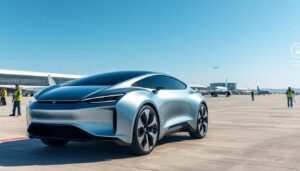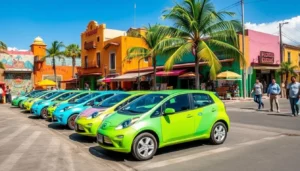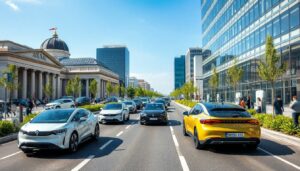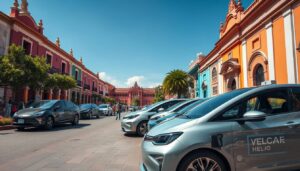Introduction
The world is shifting towards electric cars faster than ever. Countries everywhere are making plans to reduce pollution and cut down on fuel consumption. Mexico is no exception — it’s seeing a steady rise in electric vehicle sales. Why should you care? Because EVs benefit the environment, save money on fuel, and often come with government perks. The electric car market in Mexico shows big potential, with more models and better infrastructure popping up every year. Understanding what’s happening with electric cars in Mexico can help you make smarter choices or get involved early.
The Current State of Electric Cars in Mexico
Market Overview and Growth Trends
Mexico’s EV market is starting to grow but still trails behind traditional cars. In recent years, the number of electric cars sold has doubled, yet they make up less than 1% of all vehicle sales. Still, this shows rapid progress. More people are thinking about switching due to regulations, incentives, and the expanding charging network. Consumers are now more aware of electric cars, driven by rising fuel prices and environmental concern.
Popular Electric Car Models in Mexico
Several EVs are hit favorites here. The Nissan Leaf remains a top choice thanks to affordability and reliability. The Chevrolet Bolt EV is also popular, especially for its good range. Other models like Tesla’s Model 3 and BMW’s i3 are gaining traction among wealthier buyers. Most vehicles are imported, but some models, like the Nissan Leaf, are assembled locally. Prices often range from $25,000 to over $40,000 USD, influencing who buys what.
Government Policies and Incentives
Mexico’s government is trying to boost electric car use through incentives. Federal programs offer tax exemptions, which can cut prices significantly. Some states also provide perks like free parking or special lanes for EV drivers. Plus, investments are pouring into charging stations nationwide. Still, many people don’t know about these perks, and policies can vary by region. Better awareness could make more Mexicans consider switching to EVs.
Leading Manufacturers and Their Offerings
Global Brands Present in Mexico
Major automakers like Nissan, Chevrolet, Tesla, BMW, and Hyundai all sell electric cars here. Nissan’s Leaf is the best-selling EV, offering good range and low cost. Chevrolet’s Bolt is known for its affordability and decent distance per charge. Tesla’s Model 3 is a luxury option with advanced features. Hyundai has the Kona Electric, which balances price and performance. These brands target different groups — from budget buyers to luxury customers.
Local and Emerging Manufacturers
Local EV production is still in early stages. There aren’t many local brands, but collaborations between Mexican and foreign companies are happening. These efforts focus on making EVs more affordable and suited to Mexican roads. Experts see a bright future here, with new startups entering the market and more local factories planned in the coming years.
Comparison of Features, Pricing, and Range
When choosing an EV in Mexico, consider this: Range varies from 150 km (93 miles) for budget models to over 400 km (249 miles) on high-end cars. Fast charging is a plus, cutting charging time from hours to minutes. Price is key — cheaper models may have shorter ranges but cost less upfront. The right choice depends on your need for distance, budget, and access to charging.
Charging Infrastructure in Mexico
Current Status and Expansion Plans
Public charging stations are growing quickly, especially in big cities like Mexico City, Guadalajara, and Monterrey. The government and private firms are adding chargers everywhere — airports, shopping malls, and workplaces. The goal is to make charging easier, so EV owners don’t worry about running out of juice during long trips.
Types of Charging Stations
- Level 1: Standard outlet charging — slow but good for overnight charging.
- Level 2: Faster, perfect for parking at work or home.
- Fast Charging: Much quicker, can add 80% battery in 30 minutes. Compatible mostly with newer EVs like Tesla and Bolt.
Challenges and Solutions
Charging stations are mostly in cities, leaving rural areas with fewer options. To fix this, governments and companies are planning more stations across highways and smaller towns. Installing home chargers and workplace stations helps EV owners charge conveniently. Longer trips still require planning, but new infrastructure is making that easier.
Consumer Adoption and Challenges
Factors Influencing Mexican Consumers
People’s interest in EVs is rising. Many want to help the environment, save money on gas, or stay ahead of new regulations. Still, the upfront cost is a barrier for some. Financing options like loans or leasing are slowly becoming more accessible. Awareness is growing, but many still don’t fully understand EV benefits.
Common Barriers to Adoption
Price is the biggest hurdle, as EVs cost more initially than traditional cars. Limited charging stations can also make drivers nervous about distances. Range anxiety — the fear of losing battery power before reaching a station — remains a concern, especially for bigger families or long-distance trips.
Expert Insights and Consumer Testimonials
Industry experts say Mexico’s EV market will grow faster as prices drop. A recent EV owner in Mexico City says, “Once I installed a home charger, my trips became much easier.” In regions with good infrastructure, EV adoption is already booming, showing it’s possible to switch even with current challenges.
Future Outlook for Electric Cars in Mexico
Market Forecasts and Growth Opportunities
Market analysts forecast that EV sales will triple over the next five years. Local manufacturing could cut prices further, making EVs more affordable. As technology improves, expect longer ranges and faster charging.
Policy and Infrastructure Developments
New laws aim to make EVs more common. Mexico plans to build hundreds more charging stations nationwide. Innovations like smart chargers and better batteries will also help. These moves will make EVs more practical for everyday use.
Recommendations for Stakeholders
Consumers should look into current incentives and test drive different models. Manufacturers need to focus on affordability and reliable service. Policymakers must keep expanding charging infrastructure and promote awareness campaigns. Everyone benefits from a cleaner, quieter Mexico with less pollution.
Conclusion
Electric cars sold in Mexico are gaining ground, thanks to better models, government incentives, and infrastructure growth. While challenges like charging access and costs remain, progress is steady. The future looks bright for EVs in Mexico, offering cleaner air and savings for drivers. If you’re thinking about making the switch, now is a good time to consider electric mobility. The more we all support this shift, the faster we breathe easier in a greener Mexico.




